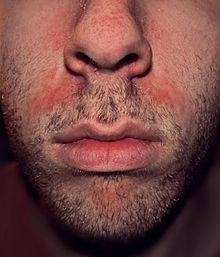| Seborrhoeic dermatitis | |
|---|---|
| Other names | Sebopsoriasis, seborrhoeic eczema, pityriasis capitis[1] |
 | |
| Seborrhoeic dermatitis of the face | |
| Specialty | Dermatology |
| Symptoms | Flaking, dry or greasy, red, itchy, and inflamed skin[2][3] |
| Duration | Several weeks to lifelong[4] |
| Causes | Multiple factors[4] |
| Risk factors | Stress, dry skin, winter, poor immune function, Parkinson disease[4] |
| Diagnostic method | Based on symptoms[4] |
| Differential diagnosis | Psoriasis, atopic dermatitis, tinea capitis, rosacea, systemic lupus erythematosus[4] |
| Treatment | Humidifier |
| Medication | Antifungal cream, anti-inflammatory agents, coal tar, phototherapy[3] |
| Frequency | ~5% (adults),[4] ~10% (babies)[5] |

Seborrhoeic dermatitis (also spelled seborrheic dermatitis in American English) is a long-term skin disorder.[4] Symptoms include flaky, scaly, greasy, and occasionally itchy and inflamed skin.[2][3] Areas of the skin rich in oil-producing glands are often affected including the scalp, face, and chest.[4] It can result in social or self-esteem problems.[4] In babies, when the scalp is primarily involved, it is called cradle cap.[2] Mild seborrhoeic dermatitis of the scalp may be described in lay terms as dandruff due to the dry, flaky character of the skin.[6] However, as dandruff may refer to any dryness or scaling of the scalp, not all dandruff is seborrhoeic dermatitis.[6] Seborrhoeic dermatitis is sometimes inaccurately referred to as seborrhoea.[4]
The cause is unclear but believed to involve a number of genetic and environmental factors.[2][4] Risk factors for seborrhoeic dermatitis include poor immune function, Parkinson's disease, and alcoholic pancreatitis.[4][6] The condition may worsen with stress or during the winter.[4] Malassezia yeast is believed to play a role.[6] It is not a result of poor hygiene.[7] Diagnosis is typically clinical and based on the symptoms present.[4][8] The condition is not contagious.[9]
The typical treatment is topical antifungal cream and anti-inflammatory agents.[3] Specifically, ketoconazole or ciclopirox are effective.[10] Seborrhoeic dermatitis of the scalp is often treated with shampoo preparations of ketoconazole zinc pyrithione, and selenium, although the latter has been partly discontinued due to concerns of selenium in higher concentrations being carcinogenic.[11]
The condition is common in infants within the first three months of age or in adults aged 30 to 70 years.[2][4][5] It tends to affect more males.[12] Seborrhoeic dermatitis is more common in African Americans, among individuals who are immune compromised, such as with HIV, and individuals with Parkinson's disease.[11][12]
- ^ Cite error: The named reference
Des2013was invoked but never defined (see the help page). - ^ a b c d e "Seborrheic Dermatitis - Dermatologic Disorders". Merck Manuals Professional Edition. Archived from the original on 26 January 2020. Retrieved 22 November 2019.
- ^ a b c d Borda LJ, Perper M, Keri JE (March 2019). "Treatment of seborrheic dermatitis: a comprehensive review". The Journal of Dermatological Treatment. 30 (2): 158–169. doi:10.1080/09546634.2018.1473554. PMID 29737895. S2CID 13686180.
- ^ a b c d e f g h i j k l m n o Ijaz N, Fitzgerald D (June 2017). "Seborrhoeic dermatitis". British Journal of Hospital Medicine. 78 (6): C88–C91. doi:10.12968/hmed.2017.78.6.C88. PMID 28614013.
- ^ a b Nobles T, Harberger S, Krishnamurthy K (August 2021). "Cradle Cap". StatPearls [Internet]. Treasure Island (FL): StatPearls Publishing. PMID 30285358. Archived from the original on 2021-01-21. Retrieved 2022-02-26.
- ^ a b c d Naldi L, Diphoorn J (May 2015). "Seborrhoeic dermatitis of the scalp". BMJ Clinical Evidence. 2015. PMC 4445675. PMID 26016669.
- ^ "Seborrheic dermatitis". American Academy of Dermatology. Archived from the original on 21 October 2017. Retrieved 20 October 2017.
- ^ Cite error: The named reference
:2was invoked but never defined (see the help page). - ^ "Seborrheic Dermatitis: What is It, Diagnosis & Treatment". Cleveland, Ohio: Cleveland Clinic. Archived from the original on 2021-10-17. Retrieved 2021-10-12.
- ^ Okokon EO, Verbeek JH, Ruotsalainen JH, Ojo OA, Bakhoya VN (May 2015). Okokon EO (ed.). "Topical antifungals for seborrhoeic dermatitis". The Cochrane Database of Systematic Reviews. 4 (5): CD008138. doi:10.1002/14651858.CD008138.pub3. PMC 4448221. PMID 25933684.
- ^ a b Cite error: The named reference
:1was invoked but never defined (see the help page). - ^ a b Cite error: The named reference
:3was invoked but never defined (see the help page).